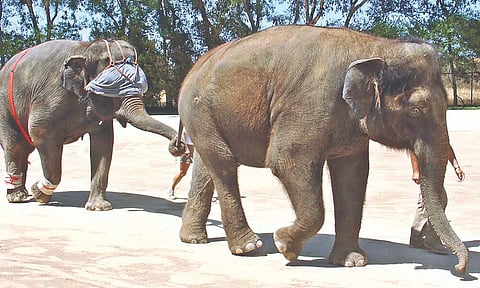

• EMILY ANTHES
NEW YORK: For a 7,600-pound Asian elephant, simply putting one foot in front of the other can be a high-stakes proposition: A trip or tumble can result in grievous injury. “The bigger you are, the harder you fall,” said John Hutchinson, an expert on large animal locomotion at the Royal Veterinary College in Britain. “If an elephant falls, it’s in big trouble.” But scientists knew little about how elephants maintain their stability as they lumber across the landscape. A new study, published in Biology Letters on Wednesday in Britain, suggests that visual feedback helps elephants time their strides. All it took were Hollywood-trained animals, a set of enormous blindfolds and a willingness to — carefully — nudge one of the planet’s largest land mammals ever so slightly off balance.
“Our elephants were going slowly, very slowly, a really slow walk,” said Dr. Hutchinson, a co-author of the study. “And they were guided by friends and by their handlers. So there was absolutely zero risk of them falling. Otherwise, I would never have done the experiment.”
Studies have shown that visual feedback helps humans fine-tune their steps. But it was not clear whether the same principle would be true for elephants, which are often active in low-light conditions and might rely more on tactile cues and physical sensations to stay on their feet.
And there are animal species that sometimes move without using sensory feedback to adjust their bodies. “We know that the time delays in the nervous system and the muscular system can be quite long, especially in large animals like elephants,” said Max Donelan, an expert in the mechanics and neurophysiology of locomotion at Simon Fraser University in Canada, who was not involved in the study. “There is that possibility that they wouldn’t rely strongly on vision because of these long sensory motor delays.” To test the importance of vision, the scientists investigated what happened when they took it away: Would elephants move differently if they were blindfolded?
“In a way, to me, it’s an embarrassingly simple experiment,” Dr. Hutchinson said. But it would require one non-negotiable condition, he realized: “Some very cooperative elephants.”
So Dr. Hutchinson and his colleague Max Kurz, a neuroscientist at the Boys Town National Research Hospital in Nebraska, set off to a California facility that trained elephants for movies, commercials and other types of entertainment. There, they studied the movements of four female elephants. The scientists strapped a GPS tracker to each animal’s torso and affixed an accelerometer to the back right foot of all four elephants. The accelerometer would produce a signal each time the foot hit the ground, allowing the researchers to track the time it took the elephant to complete a single stride.
Then the trainers had each of the elephants grab the tail of a friendly guide elephant and plod slowly behind its leader along a 300-foot walkway. In some of the trials, the scientists left the elephants’ vision unobstructed. In others, the trainers wrapped large pieces of cloth around the elephants’ faces. (Blindfolded elephants sometimes had trouble finding the guide elephant’s tail.) When the elephants could see, the timing of their strides remained relatively consistent. But the blindfolds seemed to throw the elephants off, making the timing of their strides more erratic.